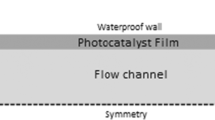Abstract
Continuous-flow microstructured technologies are now recognized as promising alternatives to batch processing for organic photochemistry, especially when light emitting diodes (LEDs) are employed as light sources. To evaluate and optimize productivity and energetic efficiency, the knowledge of the incident photon flux density is crucial. In this context, the objectives of the present work are dual: first, to transfer the classical actinometry method with Reinecke’s salt to a continuous-flow LED-driven spiral-shaped reactor and second, to propose a revised one-dimensional equivalent model for the accurate determination of the incident photon flux density in this microreactor. Experimental measurements were carried out under controlled conditions. The effects of the spectral domain and radiant power emitted, the tubing length, the presence of gas-liquid Taylor flow, and the material of the support plate were especially investigated. An expression was established for the revised one-dimensional Cartesian model, taking into account the diffuse emission of the LED array and the reflection induced by the material of the plate in which the tubing was inserted (i.e. the reflection by the backside of the microreactor wall). In this way, the incident photon flux density could be estimated with an acceptable level of accuracy, which was not the case if the usual 1D model was applied (collimated emission and no reflection).
Graphical abstract











Similar content being viewed by others
References
Hoffmann N (2008). Chem Rev 108:1052–1103
Ciana CL, Bochet CG (2007). Chimia 61:650–654
Bach T, Hehn JP (2011). Angew Chem Int Ed 50:1000–1045
Zimmerman HE (1969). Angew Chem Int Ed 8(1):1–88
Turro NJ (1986) Geometric and topological thinking in organic chemistry. Angew Chem Int Ed 25(10):882–901
Hoffmann N (2012). Photochem Photobiol Sci 11(11):1613–1641
Coyle EE, Oelgemöller M (2008). Photochem Photobiol Sci 7:1313–1322
Oelgemöller M (2012). Chem Eng Technol 35(7):1144–1152
Cambié D, Bottecchia C, Straathof NJW, Hessel V, Noël T (2016). Chem Rev 116(7):10276–11034
Loubière K, Oelgemöller M, Aillet T, Dechy-Cabaret O, Prat L (2016). Chem Eng Process 104:120–132
Haas CP, Roider T, Hoffmann RW, Tallarek U (2019). React Chem Eng 4:1912–1916
Braun AM, Peschl G, Oliveros E (2004) In: handbook of organic photochemistry and photobiology3rd edn. CRC Press
Aillet T, Loubiere K, Dechy-Cabaret O, Prat L (2012). Chem Eng Process 64:38–47
Cornet JF, Marty A, Gros JB (1997). Biotechnol Prog 13:408–415
Braun AM., Maurette MT, Oliveros E (1986). Photochemical technology, J. Wiley & Sons. New York
Kuhn H, Braslavsky SE, Schmidt R (2004). Pure Appl Chem 76:1–47
Wriedt B, Ziegenbalg D (2020). J Flow Chem 10:295–306
Aillet T, Loubiere K, Dechy-Cabaret O, Prat L (2014). Int J Chem React Eng 12:1–13
Hatchard CG, Parker CA (1956). Proceedings of the Royal Society of London Series A, Mathematical and Physical Sciences 235:518–536
Wriedt B, Kowalczyk D, Ziegenbalg D (2018). ChemPhotoChem 2(10):913–921
El Achi N, Bakkour Y, Chausset-Boissarie L, Penhoat M, Rolando C (2017). RSC Adv 7:29815–29820
Brauer HD, Schmidt R, Gauglitz G, Hubig S (1983). Photochem Photobiol 37(6):595–598
Santos AR, Ballardini R, Belser P, Gandolfi MT, Iyer VM, Moggi L (2009). Photochem Photobiol Sci 8(12):1734–1742
Rochatte V, Dahi G, Eskandari A, Dauchet J, Gros F, Roudet M, Cornet JF (2017). Chem Eng J 308:940–953
Heller HG, Langan JR (1981). J Am Chem Soc:341–343
Pitre SP, McTiernan CD, Vine W, Dipucchio R, Grenier M, Scaiano JC (2015). Sci Rep 5:1–10
Roibu A, Fransen S, Lebleci E, Meir G, Van Gerven T, Kuhn S (2018). Sci Rep 8(1):5421
Wegner EE, Adamson AW (1966). J Am Chem Soc 88(3):394–404
Radjagobalou R, Blanco JF, da Silva Freitas VD, Supplis C, Gros F, Dechy-Cabaret O, Loubière K (2019). J Photochem Photobiol A 382:111934
Radjagobalou R, Blanco JF, Petrizza L, Le Bechec M, Dechy-Carbaret O, Lacombe S, Save M, Loubière K (2021). ACS Sustain Chem Eng. https://doi.org/10.1021/acssuschemeng.0c06627
Mei M, Felis F, Dietrich N, Hébrard G, Loubière K (2020). Theor Found Chem Eng 54(1):25–47
Mei M, Dietrich N, Hébrard G, Loubière K (2020). Chem Eng Sci 222:115717
Yao C, Zhao Y, Maa H, Liu Y, Zhao Q, Chen G (2021). Chem Eng Sci 229:116017
Radjagobalou R, Blanco JF, Dechy-Cabaret O, Oelgemöller M, Loubière K (2018). Chem Eng Process 130:214–228
Terao K, Nishiyama Y, Kakiuchi K (2014). J Flow Chem 4(1):35–39
Nakano M, Nishyama Y, Tanimoto H, Morimoto T, Kakiuchi K (2016). Org Process Res Des 20(9):1626–1632
Nakano M, Morimoto T, Noguchi J, Tanimoto H, Mori H, Tokumoto SI, Koishi H, Nishiyama Y, Kakiuchi K (2019). Bull Chem Soc Jpn 92(9):1467–1473
Telmesani R, White JAH, Beeler AB (2018). ChemPhotoChem 2:865
M. N. Polyanskiy, “Refractive index database.” https://refractiveindex.info/
Acknowledgments
This work was sponsored by the French Research Agency (ANR) under the Collaborative Research Project Programme PICPOSS (ANR-15-CE07-0008-01).
J. Dauchet, J.-F. Cornet and F. Gros wish to thank the French National Agency as this work was sponsored by a public grant overseen by this Agency as part of the “Investissements d’Avenir” programme through the IMobS3 Laboratory of Excellence (ANR-10-LABX-0016) and the IDEX-ISITE initiative CAP 20-25 (ANR-16-IDEX-0001).
Author information
Authors and Affiliations
Corresponding author
Additional information
Publisher’s note
Springer Nature remains neutral with regard to jurisdictional claims in published maps and institutional affiliations.
Highlights
• Knowledge of the incident photon flux is essential for any design of a continuous-flow microstructured photoreactor.
• The actinometry method with Reinecke’s salt was successfully transferred to a continuous-flow LED-driven microreactor.
• By establishing a revised 1D Cartesian model, the incident photon flux densities could be determined with good accuracy.
Supplementary Information
ESM 1
(DOCX 11.3 mb)
Rights and permissions
About this article
Cite this article
Radjagobalou, R., Freitas, V.D.D.S., Blanco, JF. et al. A revised 1D equivalent model for the determination of incident photon flux density in a continuous-flow LED-driven spiral-shaped microreactor using the actinometry method with Reinecke’s salt. J Flow Chem 11, 357–367 (2021). https://doi.org/10.1007/s41981-021-00179-w
Received:
Accepted:
Published:
Issue Date:
DOI: https://doi.org/10.1007/s41981-021-00179-w




